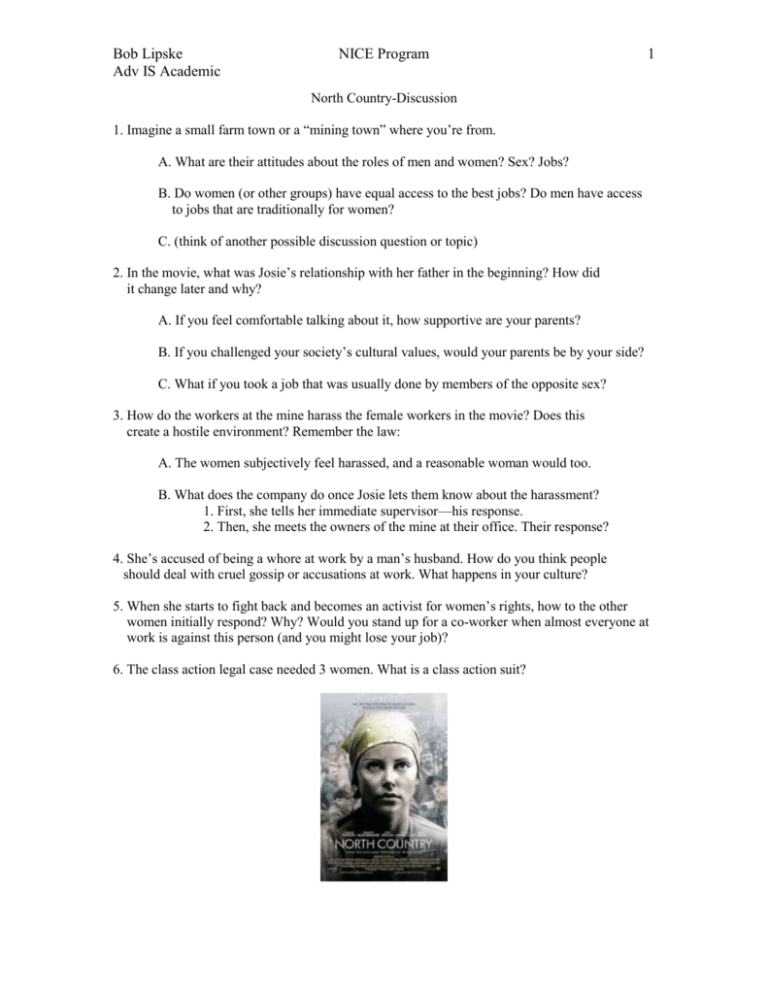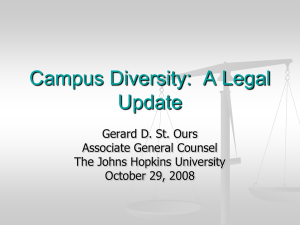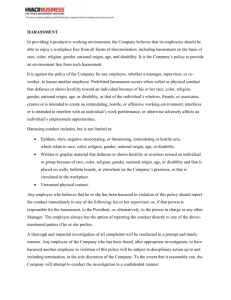
Bob Lipske
Adv IS Academic
NICE Program
1
North Country-Discussion
1. Imagine a small farm town or a “mining town” where you’re from.
A. What are their attitudes about the roles of men and women? Sex? Jobs?
B. Do women (or other groups) have equal access to the best jobs? Do men have access
to jobs that are traditionally for women?
C. (think of another possible discussion question or topic)
2. In the movie, what was Josie’s relationship with her father in the beginning? How did
it change later and why?
A. If you feel comfortable talking about it, how supportive are your parents?
B. If you challenged your society’s cultural values, would your parents be by your side?
C. What if you took a job that was usually done by members of the opposite sex?
3. How do the workers at the mine harass the female workers in the movie? Does this
create a hostile environment? Remember the law:
A. The women subjectively feel harassed, and a reasonable woman would too.
B. What does the company do once Josie lets them know about the harassment?
1. First, she tells her immediate supervisor—his response.
2. Then, she meets the owners of the mine at their office. Their response?
4. She’s accused of being a whore at work by a man’s husband. How do you think people
should deal with cruel gossip or accusations at work. What happens in your culture?
5. When she starts to fight back and becomes an activist for women’s rights, how to the other
women initially respond? Why? Would you stand up for a co-worker when almost everyone at
work is against this person (and you might lose your job)?
6. The class action legal case needed 3 women. What is a class action suit?
Bob Lipske
Adv IS Academic
NICE Program
2
7. Why does the company use a female attorney (lawyer)?
8. Why does the company lawyer focus on Josie’s previous sex life? Is this relevant?
9. Actual case: Jenson v. Eveleth Taconite Co.
A. Jenson starts working there in 1975
B. First trial: 1992—judge ruled that the company should have prevented the
misconduct. The company was ordered to educate all employees about sexual
harassment. Women offered $10,000 each. It was appealed.
D. 1998, company settles: fifteen women got $3.5 million.
Each woman got $233,000
What do you honestly think?
10. What do you think if a female was sexually harassed by a co-worker or supervisor. Then,
when she tells the company owners or executives about it, they stop the harassment.
Should she get money?
http://en.wikipedia.org/wiki/Jenson_v._Eveleth_Taconite_Co.
12. Long-term impact of the case presented in the movie:
Lois Jenson’s lawsuit was the first class action lawsuit sexual harassment lawsuit in the United
States and led to the passage of state and federal laws to protect workers.
http://www.atla.org/pressroom/facts/classactions/northcountry.aspx
If you want these addresses, e-mail me and I’ll send them to you
Timeline of this story is available here:
http://www.sexualharassmentsupport.org/JensonVsEvelethTimeline.html
Here’s the actual lawsuit:
http://laws.lp.findlaw.com/getcase/8th/case/971147p.html
Another-worse sexual harassment stories:
http://www.washingtonpost.com/wpdyn/content/article/2005/11/11/AR2005111102276_pf.html
Apropos note?: In 2005, the company closed. Bankrupt.
Book that lead to
the movie
Lois Jenson
Bob Lipske
Adv IS Academic
NICE Program
3
Discrimination and harassment
1. Vocabulary:
A. Racial slur
E. Severe or
pervasive
I. Hostile
environment
B. Ethnic slur
C. Consensual
D. Ageism
F. Brush up against
G. Sexual
orientation
H. Derogatory
J. Reasonableness
K. Cat calls
L. Perceives
test
2. What is harassment:
A. the employee subjectively perceives a hostile environment
B. the conduct was severe or pervasive enough to create a work environment that a "reasonable
person" would find hostile
Task One: Please discuss and imagine a situation where this would be true (I mean A and B)
3. Facts:
A. 62 percent of college students saying they had received a comment or gesture they found
inappropriate. Most didn't report incidents to campus employees or other officials.
Task Two: Please discuss what you have seen around the NICE Program that might be considered
an inappropriate comment or gesture. (no names)
B. One student involved with the survey said she sees harassment every day at school, including
catcalls and people brushing up against her in hallways.
C. It's a problem everywhere, said another student, Haley Pollack of Indiana University, but
especially at college. "Campuses are just highly concentrated with not only hormones but
everything else that comes with young adults."
D. Greta Franklin, 27, of the University of Maryland said her friends haven't been troubled much
by harassment. She thinks students are more likely to laugh things off. "I think a lot of people
just think, 'What's the big deal?' "
Task Three: Please decide how different cultural misunderstandings might or might not make
something seem like a big deal.
E. Many students seemed confused about how to tell when a line had been
crossed -- or where the lines should be.
Bob Lipske
Adv IS Academic
NICE Program
4
F. One survey found that men and women are almost equally likely to say they had been sexually
harassed on campus, but in different ways.
1. Men are more likely to be called anti-gay slurs, and women are more likely to receive
sexual comments or looks.
2. Women are more likely to be uncomfortable about such incidents, the survey found,
and men are more likely to laugh harassment off.
Task Four: Please come up with some possible reasons why #2 is true?
3. Gay students are more likely to be harassed and more likely to be upset about it, the
survey found.
4. "We looked at who harasses and why," said Elena Silva, the director of research at the
AAUW Educational Foundation. "A startlingly high number admit they've sexually
harassed someone, 41 percent."
a. Less than a fifth of those who said they had harassed someone
said they did it because they wanted to date that person.
b. Nearly a third said they thought the person liked the attention.
c. And almost 60 percent said they did it as a joke.
Task Five: Think about possible reasons that these individuals think people will want to date them
if they sexually harass them. (good luck)
G. Only 7 percent of students say they reported sexual harassment to a faculty
member or other college employee
http://www.washingtonpost.com/wp-dyn/content/article/2006/01/24/AR2006012401540.htm
Bob Lipske
Adv IS Academic
NICE Program
5
Vocabulary
1. New Vocabulary: (11 words or phrases)
A. Racial or ethnic slur:
Example:
B. Consensual
Example:
C. Ageism
Example:
To say something about someone because of their
race or ethnic background using offensive words.
I’m tired of his racial slurs. I’m going to talk with
the boss.
Agree to do something
It wasn’t rape. It was consensual sex.
Ageism prevents older people from getting
promoted.
D. Perceive
Example:
To sense or be aware of
I began to perceive that she was uncomfortable
with my jokes.
E. Severe or pervasive
Severe: shocking
Example:
Pervasive: spreading
everywhere
iPods are so pervasive. Everyone has one.
F. Brush up against
Example:
Lightly touch against someone
He would always brush up against the students, so
they told his boss.
G. Sexual orientation:
Example:
Someone who is bisexual, gay, or “straight”
She was fired because of her sexual orientation.
H. Derogatory
Example:
Insulting words
I asked him to stop making derogatory remarks.
I. Hostile environment
Example:
An unfriendly place to work, be, live.
The boss’ angry temper created a very hostile
environment for the workers.
J. Reasonableness test:
Example:
What a reasonable person would do in a situation.
What she did was not reasonable. It would fail
the reasonableness test.
K. Cat calls
Example:
To whistle at someone in a sexual way
The workers always made catcalls when she walked
by their office door.
Bob Lipske
Adv IS Academic
NICE Program
Reaction Paper (10 points)
6
Due at 530PM on October 26th
1. Please watch the DVD North Country within the scheduled days: Read the assigned
articles in class and participate in the class activities:
2. Write a reaction paper:
A. Have an introduction, at least two paragraphs (body) and a conclusion.
B. Minimum of 250 words.
C. Also, feel free to express your emotions, opinions, thoughts or reactions.
3. Format:
A. Typed, 12-font, Times New Roman.
B. Either submitted by hand or e-mailed to me by the due date and time.
C. Word document, spell checked.
D. Your name and the due date on the paper.
E. You create a title for the paper.
4. Movie schedule:
Monday-Wednesday
Thursday-Friday
Friday-Monday
You must return the
video by the due dates.
I encourage you to
watch the movie and
pass it on to your
classmate the next day
if possible.
If you have no DVD
player, Sinclair
Library has them. If
you need to use a
NICE TV/DVD player
let me know quickly.
It is Ok to switch with other people in your DVD group.
Group 1: XXX
Group 2: XXX
Group 3: XXX
Group 4: XXX
The movie will be discussed in class on Monday, October 22th.
There will be a quiz on the movie on Tuesday, October 23th. You can use any notes that
you have taken. You cannot copy another person’s notes for the quiz.
The paper is due by 530PM on Friday, October 26th.
Bob Lipske
Adv IS Academic
NICE Program
7
Reaction Papers
1. Definition: Reaction or response papers are usually requested by teachers so that you'll
consider carefully what you think or feel about something you've read, discussed or
watched. You too will write a reaction paper based on a movie, reading assignments and
classroom activities and discussions. No research is needed.
2. Process: Read or watch whatever you've been asked to respond to, and while doing
that, think about the following questions.
A. How do you feel about the topic?
B. What do you agree or disagree with?
C. Can you identify with the situation?
D. What would be the best way to evaluate the source (book, movie, handout)
E. Is everything logical? Are their flaws (weaknesses)?
3. Keeping your responses to these questions in mind, follow the following prewriting
steps.
A. Prewriting for Your Reaction Paper: The following statements could be used in
a reaction/response paper. Complete as many statements as possible, from the
list below, about what you just read:
1. My Reaction to What I Just Read Is That . . .
2. I think that
3. I see that
4. I feel that
5. It seems that
6. In my opinion,
7. Because
8. One powerful thing
9. In addition/For example/Moreover/However/Consequently
10. Finally, In conclusion,
B. What you've done in completing these statements is written a very rough
reaction/response paper outline. Now it needs to be organized.
Bob Lipske
Adv IS Academic
NICE Program
8
C. Organizing Your Reaction Paper: A reaction/response paper has an
introduction, a body, and a conclusion.
Introduction:
1. Sentence 1: This sentence should give the title, author, and publication
you read, or movie you’ve seen.
2. Sentences 2, 3, and sometimes 4: These sentences give a brief summary
of what you read (nutshell) or watched.
3. Sentence 5:This sentence is your thesis statement. You agree, disagree,
identify, or evaluate.
4. Your introduction should include a concise, one sentence, focused
thesis. This is the focused statement of your reaction/response.
D. The body should contain paragraphs that provide support for your thesis.
Decide on the key points that will focus your ideas. These will be your topic
sentences.
1. Topic Sentence
2. detail -- example --quotation --detail -- example -- quotation -- detail –
example -- quotation -- detail -- example –quotation
3. Summary Sentence
E. Paragraph organizational structures:
1. Author/director
1. Author/director
2. You (same)
2. You (your contrast of author)
F. The conclusion can be a restatement of what you said in your paper. It also be a
comment which focuses your overall reaction. Finally, it can be a prediction of
the effects of what you're reacting to. Note: your conclusion should include no
new information.
http://leo.stcloudstate.edu/acadwrite/reaction.html
Bob Lipske
Adv IS Academic
NICE Program
9
Sample Reaction Paper One
The topics covered this week are interesting in that they have great implications
for democratic theory. Issue voting would indicate an attentive public, while
retrospective voting could render campaign promises meaningless. The enterprise of
assessing the determinants of vote choice is an extremely complicated one that suffers
from several common difficulties.
The first is the availability of data. Panel studies and surveys are expensive and
time consuming, and therefore not consistently performed. This hodge-podge of
available data forces researchers to draw broad conclusions from data covering limited
periods of time. For example, Marcus and Converse used data from two elections. The
Kiinder and Abelson piece discussed by Asher found that candidate assessment fell along
two separate dimensions – competence and integrity, yet the data was drawn during the
Carter administration. Carter may be a uniquely extreme example; an individual
especially strong on integrity and weak on competence. Similarly, CCMS drew
conclusions about issue salience during a particularly non-contentious time period. Many
of these studies may be reporting substantially time-bound phenomena.
Another difficulty arises from drawing conclusions based on particular cases. For
example, Carmines and Stimson use race as the primary example of an “easy issue” and
Vietnam policy as an example of a “hard issue” (both derived from data on the 1972
presidential election). Though these examples may very well prove consistent with the
conclusions about types of issue voting (or rather, the one legitimate type), it may be that
these results arise from the particular examples.
One particular observation is that the Fiorina conceptualization of retrospective
voting seems plausible, yet I’m left wondering about the effect of past experience with a
party in the distant past as compared with that of the recent past. For example, if a voter
came of age in a time of single party dominance, how would past experience with the
other party be calculated?
The transition of the voting literature from party ID driven to candidate centered
is more intuitively satisfying, and may reflect a progression in understanding, due to the
accumulation of scholarly work, as well as a temporal shift in voting behavior itself. The
Asher piece sums up the research in the field effectively, stating that “the ferment that
currently exists in the study of voting behavior is an indication that this is a subfield in
which important work remains to be done.”
http://www.csus.edu/indiv/n/nalderk/Sample%20Reaction%20Paper.htm









